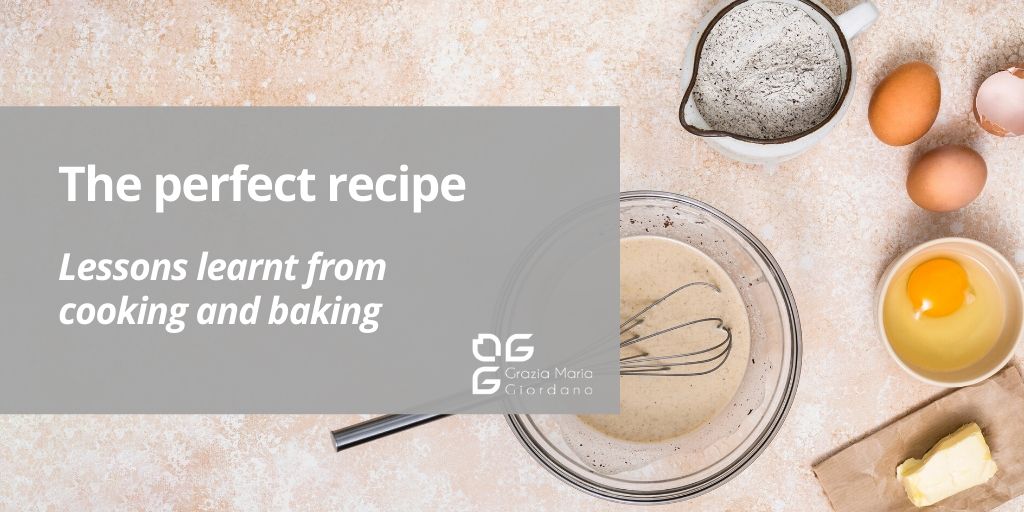In Italy, food is almost a religion.
Put two Italians in a room, and the first topic will be food. They’ll begin to praising this or that regional product. The way his/her mother/aunt/grandmother cooks that particular dish is better than anyone else’s.
So, you won’t be surprised to know that as an Italian, I spend most of my free-time, well, cooking.
I love baking. Particularly dough in all its forms: bread, pizza, focaccia, and of course, cakes and desserts. And never satisfied with what I already know, I follow classes to learn new techniques & recipes as well.
From my time spent cooking, I have learnt some lessons that can be applied beyond the realm of cooking.
When you look for a recipe on the Internet, you’ll find an unbelievable number of varieties for the same dish. Your experience says the same. If you ask any Italian how to cook a specific dish, each of will come up with a very different version of the same dish. Some recipes differ just by a few things: a slightly altered ingredient list, somewhat different techniques. Others will be more complex and will use higher-level methods. One thing you can be assured of that all of them will result in a delicious meal.
It’s up to you to find the version that you like best, that you feel most comfortable enough cooking and the game is on.
Personally, when I want to try something new, I start researching recipes on the Internet, compare ingredient lists and techniques, and then I choose to make 2/3 different versions to find the one that better suits my palate.
There are two lessons that I have pulled out from this continuous process:
-
The power of endless solutions:
It doesn’t matter how complex a problem is, there is always more than one solution to it. What you need is to make an effort to identify them with an open mind and clarity about your objective, as sometimes the differences are small yet significant. Consider what your (sub)conscious biases are: do I have that ingredient or not, do I like that ingredient, can I get that ingredient on time. Finally, list and compare all the possible alternatives. Your problem will always have a solution!
-
One won’t fit all:
Each of us has different tastes. That’s why there are so many alternatives. At the same time each problem, each organisation is different, and that’s why you need to address it in the best (customised) way you can. What works for one organisation, won’t necessarily work in another one. Models, frameworks and approaches (read recipes) are, of course, more than useful as they provide a reference to be used and to guide your action. They offer the basics (techniques) to make your solution (aka dish) robust and sustainable, but they are not a goal in themselves. Each organisation needs to find its own feet and to develop the solution that fits best, provided some basics are met.
When you move from ‘simple’ cooking to baking, your learning jumps to the next level.
The ingredients for baking bread or pizza are straightforward: flour, water, yeast, salt and olive oil or some other kind of fat (butter usually). Now you already imagine yourself as the Next Baker mixing ingredients and coming up with the most delicious pizza you ever tasted. Well, that might come true provided you follow some rules.
Baking & pastry making is a precise science. Each ingredient needs to be present in the recipe in an specific quantities for an optimal result. Of course, those quantities can vary. Again if you look on the Internet, there will be tons of different recipes, but if you carefully read them you’ll notice that if you change an ingredient, another one will need to change too! It’s all about balance and proportions.
Every ingredient plays a different role in the final product. Add more butter, and you’ll have a softer result, for example, but fat makes it more challenging to create the gluten binding which is at the base of any baking product. Another example is that in the shortbread pastry, sugar and butter play an opposite role. Add sugar, you’ll get a crunchier pastry, add butter, and you’ll get a much more fluffy result.
I continue to learn essential lessons:
-
Balance:
In any recipe, the balance among all the ingredients is critical. Otherwise, your product won’t have the appeal shown in the book. Balance is also at the base of any robust organisational solution. All the parts and mechanisms need to be evaluated appropriately and measured to get to a congruous output.
-
Interdependence and reciprocal influence:
Each ingredient doesn’t live in a void. Each component interacts with the others and will have a different impact on the outcome, hence why you cannot modify the quantity or the characteristics of one of them without looking at the others.
This simple reasoning can be translated into any organisation, where a function or department or a process is intimately related to the others. Whenever something changes at one point in an organisation, it has an impact in other areas, which you will then need to understand and manage. This is the cooking/managerial version of the butterfly effect!
Cooking is an excellent school for learning project management skills. If you need to cook a simple omelette or a more sophisticated dessert, there are some steps you need to take to be sure you get to the desired result on time. This becomes more complicated when you are cooking a an elaborated meal with several preparations overlapping each other, and you learn to use the idle time of one dish (say, for example, the rising time of a baked product) to move forward to another one. Of course, once you are experienced enough, you can skip some phases or shorten the time, but you do it with the full awareness of the implications this might have on the final product (for example, shortening the rising time of bread will impact its softness at the end).
And you, what have you learnt from your pastime activities?






